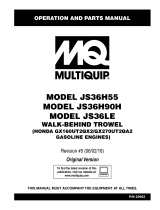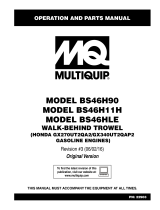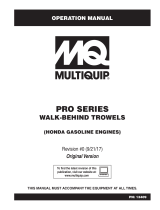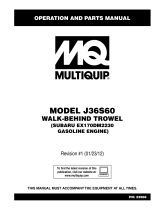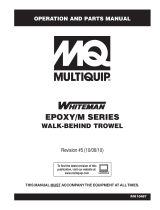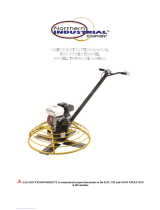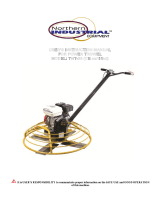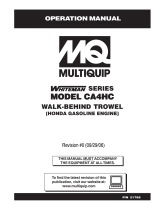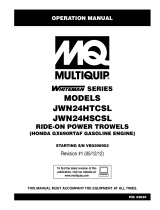Page is loading ...

OPERATION AND PARTS MANUAL
THIS MANUAL MUST ACCOMPANY THE EQUIPMENT AT ALL TIMES.
To find the latest revision of this
publication, visit our website at:
www.multiquip.com
MODEL CS24H55E
WALK-BEHIND TROWEL
(HONDA GX160UT2QX2
GASOLINE ENGINE)
Revision #0 (5/06/15)
P/N 24306
Original Version

PAGE 2 — CS24H55E WALK-BEHIND TROWEL • OPERATION AND PARTS MANUAL — REV. #0 (5/06/15)
Gasoline engine exhaust and some of
its constituents, and some dust
created by power sanding, sawing,
g rinding, d rillingand o ther
construction activities contain
chemicals knowto cause cancer, birth
defects and other reproductive harm.
Some examples of these chemicals are:
Lead from lead-based paints
Crystalline silica from bricks
Cement and other masonryproducts
Arsenic and chromium from chemically
treated lumber
Your risk from these exposures varies,
depending on how often youdo this
type of work. To reduce your exposure
to these chemicals: work in a
well-ventilated area, and work with
approved safety equipment, suchas
dust masks that are specially designed
to filter out microscopic particles.
ALWAYS
FUEL AND CHEMICAL EXPOSURE WARNINGS

CS24H55E WALK-BEHIND TROWEL • OPERATION AND PARTS MANUAL — REV. #0 (5/06/15) — PAGE 3
Grinding/cutting/drilling of masonry, concrete, metal and
other materials with silica in their composition may give
off dust or mists containing crystalline silica. Silica is a
basic component of sand, quartz, brick clay, granite and
numerous other minerals and rocks. Repeated and/or
substantial inhalation of airborne crystalline silica can
cause serious or fatal respiratory diseases, including
silicosis.In addition, California and some other
authorities have listed respirable crystalline silica as a
substance known to cause cancer. When cutting such
materials, always follow the respiratory precautions
mentioned above.
WARNING
Grinding/cutting/drilling of masonry, concrete, metal and
other materials can generate dust, mists and fumes
containing chemicals known to cause serious or fatal
injury or illness, such as respiratory disease, cancer,
birth defects or other reproductive harm. If you are
unfamiliar with the risks associated with the particular
process and/or material being cut or the composition of
the tool being used, review the material safety data
sheet and/or consult your employer, the material
manufacturer/supplier, governmental agencies such as
OSHA and NIOSH and other sources on hazardous
materials. California and some other authorities, for
instance, have published lists of substances known to
cause cancer, reproductive toxicity,or other harmful
effects.
Control dust, mist and fumes at the source where
possible. In this regard use good work practices and
follow the recommendations of the manufacturers or
suppliers, OSHA/NIOSH, and occupational and trade
associations.Water should be used for dust
suppression when wet cutting is feasible. When the
hazards from inhalation of dust, mists and fumes cannot
be eliminated, the operator and any bystanders should
always wear a respirator approved by NIOSH/MSHA for
the materials being used.
WARNING
SILICOSIS WARNING RESPIRATORY HAZARDS
SILICOSIS/RESPIRATORY WARNINGS

PAGE 4 — CS24H55E WALK-BEHIND TROWEL • OPERATION AND PARTS MANUAL — REV. #0 (5/06/15)
TABLE OF CONTENTS
CS24H55E
WALK-BEHIND TROWEL
Fuel and Chemical Exposure Warnings .................. 2
Silicosis/Respiratory Warnings ................................ 3
Table of Contents ..................................................... 4
Training Checklist .................................................... 5
Daily Pre-Operation Checklist ................................. 6
Safety Information .............................................. 7-11
Trowel Specifications/Dimensions ......................... 12
Engine Specifications ............................................ 13
General Information ............................................... 14
Trowel Components ............................................... 15
Engine Components .............................................. 16
Assembly and Installation ................................. 17-19
Inspection ......................................................... 20-22
Operation .......................................................... 23-28
Options .................................................................. 29
Maintenance ..................................................... 30-37
Troubleshooting ................................................ 38-41
Wiring Diagram ...................................................... 42
Explanation of Code in Remarks Column.............. 44
Suggested Spare Parts ......................................... 45
Component Drawings
Nameplate and Decals Assembly ..................... 46-47
Folding Handle Assembly ................................. 48-49
Standard Handle Assembly (Option). ............... 50-51
Rotating Guard Ring, Handle, and Yoke Assy. .. 54-55
Gearbox Assembly ........................................... 56-57
Engine and Clutch Assembly ............................ 58-59
Spider Assembly ............................................... 60-61
Float Pan Assembly .......................................... 62-63
Engine Service Parts ........................................ 64-65
Terms and Conditions Of Sale — Parts ................. 66
NOTICE
Specifications and part numbers are subject to change
without notice.

CS24H55E WALK-BEHIND TROWEL • OPERATION AND PARTS MANUAL — REV. #0 (5/06/15) — PAGE 5
TRAINING CHECKLIST
Training Checklist
No. Description OK? Date
1
Read operation manual
completely.
2
Machine layout, location of
components, checking of engine
oil level.
3 Fuel system, refueling procedure.
4
Operation of controls (machine
not running).
5
Safety controls, safety stop switch
operation.
6 Emergency stop procedures.
7 Startup of machine, engine choke.
8 Maintaining a hover.
9 Maneuvering.
10 Pitching.
11 Concrete fi nishing techniques.
12 Shutdown of machine.
13 Lifting of machine (lifting bale).
14 Machine transport and storage.

PAGE 6 — CS24H55E WALK-BEHIND TROWEL • OPERATION AND PARTS MANUAL — REV. #0 (5/06/15)
DAILY PRE-OPERATION CHECKLIST
Daily Pre-Operation Checklist
1 Engine oil level
2 Gearbox oil level
3 Condition of blades
4 Blade pitch operation
5 Safety stop switch operation

CS24H55E WALK-BEHIND TROWEL • OPERATION AND PARTS MANUAL — REV. #0 (5/06/15) — PAGE 7
SAFETY INFORMATION
Do not operate or service the equipment before reading
the entire manual. Safety precautions should be followed
at all times when operating this equipment.
Failure to read and understand the safety
messages and operating instructions could
result in injury to yourself and others.
SAFETY MESSAGES
The four safety messages shown below will inform you
about potential hazards that could injure you or others. The
safety messages specifically address the level of exposure
to the operator and are preceded by one of four words:
DANGER, WARNING, CAUTION
or NOTICE.
SAFETY SYMBOLS
DANGER
Indicates a hazardous situation which, if not avoided,
WILL result in DEATH or SERIOUS INJURY.
WARNING
Indicates a hazardous situation which, if not avoided,
COULD result in DEATH or SERIOUS INJURY.
CAUTION
Indicates a hazardous situation which, if not avoided,
COULD result in MINOR or MODERATE INJURY.
NOTICE
Addresses practices not related to personal injury.
Potential hazard associated with the operation of this
equipment will be referenced with hazard symbols
which
may appear throughout this manual in conjunction with
safety messages.
Warning decals
associated with the operation of this
equipment are defined below:
Inhaling exhaust fumes can result in severe
injury or death.
Only operate equipment in well ventilated areas.
inhale exhaust gases/fumes.DO NOT
WARNING
Lethal Exhaust Gas Hazard
HOT PARTS can burn skin.
CAUTION
Burn Hazard
touch hot parts. Allow machine a sufficient
amount of time to cool before performing maintenance.
DO NOT
Gasoline fuel can cause fire or explosion. Stop
engine before refueling.
Keep cigarettes, sparks and flames away from hot
surfaces.
WARNING
Explosive Fuel Hazard
SYMBOL
SAFETY HAZARD
Keep hands and feet clear of guard rings.
Stop engine before servicing.
WARNING
Rotating Blade Hazard
To avoid injury you must read and
understand operator’s manual before
using this machine.
P/N 23700
allow any person
to stand underneath the trowel while lifting.
NEVER
P/N 360
99
ALWAYS wear protective clothing when
operating this equipment
This machine to be operated by qualified
personnel. Ask for training as needed.
Lifting Crush Hazard
lift trowel with pans attached.DO NOT
WARNING
WARNING
Read Manual
NEVER operate this equipment with guards
removed. Keep hands clear.
WARNING
Training
Guard Hazard
WARNING
make sure handle is securely attached.
On Quick Pitch™ models make sure T-Handle
latch is locked (engaged).
ALWAYS
DECAL
SAFETY HAZARD

PAGE 8 — CS24H55E WALK-BEHIND TROWEL • OPERATION AND PARTS MANUAL — REV. #0 (5/06/15)
SAFETY INFORMATION
GENERAL SAFETY
CAUTION
NEVER operate this equipment without proper protective
clothing, shatterproof glasses, respiratory protection,
hearing protection, steel-toed boots and other protective
devices required by the job or city and state regulations.
Avoid wearing jewelry or loose fitting clothes that may
snag on the controls or moving parts as this can cause
serious injury.
NEVER operate this equipment when not
feeling well due to fatigue, illness or when
under medication.
NEVER operate this equipment under the
influence of drugs or alcohol.
ALWAYS clear the work area of any debris, tools, etc.
that would constitute a hazard while the equipment is
in operation.
No one other than the operator is to be in the working
area when the equipment is in operation.
DO NOT use the equipment for any purpose other than
its intended purposes or applications.
NOTICE
This equipment should only be operated by trained and
qualified personnel 18 years of age and older.
Whenever necessary, replace nameplate, operation and
safety decals when they become difficult read.
Manufacturer does not assume responsibility for any
accident due to equipment modifications. Unauthorized
equipment modification will void all warranties.
NEVER
use accessories or attachments that are not
recommended by Multiquip for this equipment. Damage
to the equipment and/or injury to user may result.
ALWAYS know the location of the nearest
fire extinguisher.
ALWAYS know the location of the nearest
first aid kit.
ALWAYS know the location of the nearest phone or
keep
a phone on the job site.
Also, know the phone numbers
of the nearest ambulance, doctor and
fire department.
This information will be invaluable in the case of an
emergency.

CS24H55E WALK-BEHIND TROWEL • OPERATION AND PARTS MANUAL — REV. #0 (5/06/15) — PAGE 9
SAFETY INFORMATION
TROWEL SAFETY
DANGER
Engine fuel exhaust gases contain poisonous carbon
monoxide. This gas is colorless and odorless, and can
cause death if inhaled.
The engine of this equipment requires an adequate free
flow of cooling air. NEVER operate this equipment in any
enclosed or narrow area
where free flow of the air is
restricted. If the air flow is
restricted it will cause injury
to people and property and
serious damage to the
equipment or engine.
NEVER operate the equipment in an explosive
atmosphere or near combustible materials. An
explosion or fire could result causing severe
bodily harm or even death.
WARNING
ALWAYS keep clear of rotating or moving
parts while operating the trowel.
DO NOT start or operate the trowel if the
drive train will not disengage. Centrifugal
force between the trowel and surface when starting can
cause uncontrolled handle movement that can cause
serious injury. The handle must not move while pulling
the engine recoil starter.
NEVER disconnect any emergency or safety devices.
These devices are intended for operator safety.
Disconnection of these devices can cause severe injury,
bodily harm or even death. Disconnection of any of these
devices will void all warranties.
CAUTION
NEVER stand on trowel during operation.
NEVER lubricate components or attempt service on a
running machine.
NEVER place your feet or hands inside the guard rings
while starting or operating this equipment.
DANGEROUS
GAS FUMES
K
E
E
P
C
L
E
A
R
ALWAYS keep work area
clear around the trowel.
Make sure it is free of
debris and objects.
NOTICE
ALWAYS keep the machine in proper running condition.
Fix damage to machine and replace any broken parts
immediately.
ALWAYS
store equipment properly when it is not being
used. Equipment should be stored in a clean, dry location
out of the reach of children and unauthorized personnel.
A safety manual for operating and maintenance
personnel of concrete power trowels produced by the
Association of Equipment Manufacturers (AEM) can be
obtained for a fee by ordering through their website at
www.aem.org.
Order FORM PT-160
ENGINE SAFETY
WARNING
DO NOT
place hands or fingers inside engine
compartment when engine is running.
NEVER
operate the engine with heat shields or
guards removed.
Keep fingers, hands hair and clothing away
from all moving parts to prevent injury.
DO NOT remove the engine oil drain plug
while the engine is hot. Allow the oil to cool before
performing maintenance. This will prevent scalding of
personnel.
CAUTION
NEVER touch the hot exhaust manifold,
muffler or cylinder. Allow these parts to cool
before servicing equipment.

PAGE 10 — CS24H55E WALK-BEHIND TROWEL • OPERATION AND PARTS MANUAL — REV. #0 (5/06/15)
SAFETY INFORMATION
NOTICE
NEVER run engine without an air filter or with a dirty air
filter. Severe engine damage may occur. Service air filter
frequently to prevent engine malfunction.
NEVER tamper with the factory settings
of the engine or engine governor. Damage
to the engine or equipment can result
if operating in speed ranges above the
maximum allowable.
FUEL SAFETY
DANGER
DO NOT add fuel to equipment if it is placed inside
truck bed with plastic liner. Possibility exists of explosion
or fire due to static electricity.
DO NOT start the engine near spilled fuel or combustible
fluids. Fuel is extremely flammable and its vapors can
cause an explosion if ignited.
ALWAYS refuel in a well-ventilated area, away from
sparks and open flames.
ALWAYS use extreme caution when working with
flammable liquids.
DO NOT fill the fuel tank while the engine is running
or hot.
DO NOT overfill tank, since spilled fuel could ignite if it
comes into contact with hot engine parts or sparks from
the ignition system.
FUEL
FUEL
Store fuel in appropriate containers, in well-ventilated
areas and away from sparks and flames.
NEVER use fuel as a cleaning agent.
DO NOT smoke around or near the
equipment. Fire or explosion could result
from fuel vapors or if fuel is spilled on a
hot engine.
TRANSPORTING SAFETY
CAUTION
NEVER allow any person or animal to
stand underneath the equipment while
lifting.
NOTICE
Some walk-behind trowels can be lifted or moved by two
people utilizing lifting tubes or other special attachments.
Generally, however, they must be lifted using lifting bales
and cranes, hoists, or forklifts.
NEVER
transport trowel with float pans attached unless
safety catches are used and are specifically cleared for
such transport by the manufacturer.
NEVER
hoist the trowel more than three feet off the
ground with float pans attached.
Before lifting, make sure that the lifting bales are not
damaged.
Always make sure crane or lifting device has been
properly secured to the lifting bales of the equipment.
ALWAYS shutdown engine before transporting.
NEVER lift the equipment while the engine is running.
Tighten fuel tank cap securely and close fuel cock to
prevent fuel from spilling.
Use adequate lifting cable (wire or rope) of sufficient
strength.
DO NOT lift machine to unnecessary heights.
ALWAYS
tie down equipment during transport by
securing the equipment with rope.

CS24H55E WALK-BEHIND TROWEL • OPERATION AND PARTS MANUAL — REV. #0 (5/06/15) — PAGE 11
SAFETY INFORMATION
ENVIRONMENTAL SAFETY/DECOMMISSIONING
NOTICE
Decommissioning is a controlled process used to safely
retire a piece of equipment that is no longer serviceable.
If the equipment poses an unacceptable and unrepairable
safety risk due to wear or damage or is no longer cost
effective to maintain (beyond life-cycle reliability) and is to
be decommissioned (demolition and dismantlement),be
sure to follow rules below.
DO NOT pour waste or oil directly onto the ground, down
a drain or into any water source.
Contact your country's Department of
Public Works or recycling agency in your
area and arrange for proper disposal of
any electrical components, waste or oil
associated with this equipment.
When the life cycle of this equipment is over, remove
battery and bring to appropriate facility for lead
reclamation. Use safety precautions when handling
batteries that contain sulfuric acid.
When the life cycle of this equipment is over, it is
recommended that the trowel frame and all other metal
parts be sent to a recycling center.
Metal recycling involves the collection of metal from
discarded products and its transformation into raw
materials to use in manufacturing a new product.
Recyclers and manufacturers alike promote the process
of recycling metal. Using a metal recycling center
promotes energy cost savings.
EMISSIONS INFORMATION
NOTICE
The gasoline engine used in this equipment has been
designed to reduce harmful levels of carbon monoxide
(CO), hydrocarbons (HC) and nitrogen oxides (NOx)
contained in gasoline exhaust emissions.
This engine has been certified to meet US EPA Evaporative
emissions requirements in the installed configuration.
Attempting to modify or make adjustments to the engine
emmission system by unauthorized personnel without
proper training could damage the equipment or create an
unsafe condition.
Additionally, modifying the fuel system may adversely affect
evaporative emissions, resulting in fines or other penalties.
Emission Control Label
The emission control label is an integral part of the emission
system and is strictly controlled by regulation(s).
The label must remain with the engine for its entire life.
If a replacement emission label is needed, please contact
your authorized engine distributor.

PAGE 12 — CS24H55E WALK-BEHIND TROWEL • OPERATION AND PARTS MANUAL — REV. #0 (5/06/15)
TROWEL SPECIFICATIONS/DIMENSIONS
Table 1. Trowel Specifications
A–Height (Lifting Bale) – mm (in.) 700 (28) Path Width – mm (in.) 914 (36)
B–Height (Handle) – mm (in.) Standard 1000 (39)
Rotor – RPM (Dry Concrete) 60-115
Folding Handle 960 (38)
C–Width (Ring Diameter) – mm (in.) 610 (24) Gear Box Oil Capacity – ml (oz.)
828 (28)
D–Length – mm (in.) Standard
Folding Handle
1,800 (71)
1600 (63)
Shipping Weight – kg (lbs.) Standard
Folding Handle
75.5 (166)
73.5 (162)
Number of Blades 4
Figure 1. Dimensions
SXHS HANDLE FXHS HANDLE
C
D
C
D
TOP VIEW TOP VIEW
AAAAAAA
AB
B
SIDE VIEW SIDE VIEW
A

CS24H55E WALK-BEHIND TROWEL • OPERATION AND PARTS MANUAL — REV. #0 (5/06/15) — PAGE 13
ENGINE SPECIFICATIONS
Table 2. CS24H55E Noise and Vibration Emissions
Model
CS24H55E
Guaranteed ISO 11201:2010 Based
Sound Pressure Level at Operator Station in dB(A)
88
Guaranteed ISO 3744:2010 Based
Sound Power Level in dB(A)
104
Hand-Arm Vibration Per ISO 5349-1:
2001 in m/s
2
SA(8)
Standard Handle (SXHS) 0.96
Folding Handle (FXHS) 2.43
Table 3. Engine Specifications
Model Honda GX160UT2QX2 Engine
Type Air-cooled 4 stroke, Single Cylinder, OHV, Horizontal Shaft Gasoline Engine
Bore X Stroke 68 mm x 45 mm (2.70 in. X 1.8 in.)
Displacement 163 cc (9.9 cu-in.)
Max. Output 5.5 H.P. @ 3600 RPM
Fuel Tank Capacity
Approx. 3.6 Liters
(0.95 U.S. Gallons)
Fuel Unleaded Gasoline
Lube Oil Capacity 0.6 liters (0.63 qt.)
Oil Type 4-Stroke API, SF or SG SAE 10W-30 General Use
Speed Control Method Centrifugal Flyweight Type
Cooling System Forced Air
Starting Method Recoil Start
Spark Plug Type BPR6ES NGK
Spark Plug Gap 0.70 - 0.80 mm (0.028-0.031 in.)
Dimensions (L x W x H)
312 X 362 X 335 mm
(12.3 x 14.3 X 13.2 in.)
Dry Net Weight 15 Kg. (33.1 lbs.)
NOTES:
1. Sound Pressure and Power Levels are “A” weighted Measures per ISO 226:2003 (ANSI S1.4-1981). They are measured with the operating
condition of the machine which generates the most repeatable but highest values of the sound levels. Under normal circumstances, the sound
level will vary depending on the condition of the material being worked upon.
2. The vibration level indicated is the vector sum of the RMS (Root Mean Square) Values of amplitudes on each axis, standardized to an 8 hour
exposure period, and obtained using operating condition of the machine that generates the most repeatable but highest values in accordance
with the applicable standards for the machine.
3. Per EU Directive 2002/44/EC, the daily exposure action value for hand-arm vibration is 2.5 m/s
2
SA(8). The daily exposure limit value is
1.15 m/s
2
SA(8).

PAGE 14 — CS24H55E WALK-BEHIND TROWEL • OPERATION AND PARTS MANUAL — REV. #0 (5/06/15)
GENERAL INFORMATION
INTENDED USE
Operate this trowel, tools and components in accordance
with the manufacturer's instructions. Use of any other tools
for stated operation is considered contrary to designated
use. The risk of such use lies entirely with the user. The
manufacturer cannot be held liable for damages as a result
of misuse
TROWEL FAMILIARIZATION
This walk-behind trowel is designed for the floating and
finishing of concrete slabs.
Take a walk around the trowel. Take notice of all the major
components (Figure 2) like the engine, blades, steering
handle, kill switch, gearbox, etc. Check that there is always
oil in the engine.
Read all the safety instructions carefully. Safety instructions
will be found throughout this manual and on the trowel. Keep
all safety information in good, readable condition. Operators
should be well trained on the operation and maintenance
of the trowel.
Before using your trowel, test it on a flat watered down
section of finished concrete that is free of any debris and
other objects.
This trial test run will increase your confidence in using the
trowel and at the same time it will familiarize you with the
trowel’s controls. In addition you will understand how the
trowel handles under actual conditions.
ENGINE
This trowel is equipped with either a HONDA 5.5
gasoline engine. Refer to the engine owner’s manual for
instructions regarding the operation and maintenance of
your engine. Please contact your nearest Multiquip Dealer
for a replacement should the original manual disappear or
otherwise become unusable.
DRIVE SYSTEM
Power is transferred from the engine to the gearbox input
shaft via a V-belt pulley drive system. The pulley engages
using a centrifugal clutch. See parts section of this manual
for a breakdown of the drive system.
GEARBOX
The gearbox is located beneath the engine and transfers
power to the spider assembly. The gearbox controls the
rotational speed of the trowel and is equipped with two
shafts (input and output).
SPIDER
The vertical output shaft of the gearbox connects to a cast
hub called the spider. The spider has 4 arms that extend
outward that are used for attachment of blades or other
accessories. Remember as the gearbox output shaft rotates
so does the spider assembly.
GUARD RING
This unit is equipped with a safety guard ring. It is designed
to help protect items from coming into contact with the
rotating blades while the trowel is in operation.
BLADES
The blades of the trowel finish the concrete as they are
rotated around the surface. This trowel comes equipped
with four combination blades (8 in./203 mm wide) per
rotor equally spaced in a radial pattern and attached to a
vertical rotating shaft by means of a spider assembly.
CENTRIFUGAL
SAFETY STOP SWITCH (OPTION)
In the event of a trowel runaway condition (operator
releases handlebars during operation), the centrifugal
safety stop switch will stop the engine and bring the trowel
to a halt
TRAINING
For proper training, please use the “TRAINING CHECKLIST”
form located in the front of this manual. This checklist will
provide an outline for an experienced operator to provide
training to a new operator.
CAUTION
NEVER attempt to lift the trowel by yourself. ALWAYS get
the assistance of another person to help lift the trowel.

CS24H55E WALK-BEHIND TROWEL • OPERATION AND PARTS MANUAL — REV. #0 (5/06/15) — PAGE 15
TROWEL COMPONENTS
8
4
4
5
5
3
3
14
13
9
12
11
10
7
OPTION
1
2
2
6
6
15
16
16
Figure 2. Trowel Control and Components
Figure 2 shows the location of the basic controls or
components, for the trowel. Listed below is a brief explanation
of each control or component.
1. Folding Handle Release Star Wheel — This star
wheel allows for the positioning of the upper folding
handle. Turn counterclockwise to release folding
handle. Turn clockwise to lock folding handle in place.
2. Blade Pitch Star Wheel — Turn star wheel clockwise
to increase blade pitch and counterclockwise to
decrease pitch.
3. Throttle Control Lever — Controls the speed of the
engine. Move the hand lever towards the operator to
increase engine speed (high), away from the operator
to decrease engine speed (low).
4. Hand Grip/Handle Bar — When operating the trowel,
place both hands on each grip to maneuver the
trowel. Replace hand grips when they become worn
or damaged.
5. Handle Bar Pad — Foam leather pad that protects the
body when coming in contact with handle bar.
6. Operator Presence Lever (Optional) — This lever
must be engaged (squeezed), when starting the
engine. Releasing the lever will stop the engine
7. V-Belt Cover — Remove this cover to gain access to
the V-belt. NEVER operate the trowel with this cover
removed.
8. Blades — This trowel is equipped with special
combination blades. Designed specifically for edging.
In addition, float discs can be attached to the trowel
arms that will allow the trowel to float on "wet" concrete.
9. Trowel Arm — NEVER operate the trowel with a bent,
broken or out of adjustment trowel arm. If the blades
show uneven wear patterns or some blades wear out
faster than others, the trowel arm may need to be
replaced.
10. Rotating Guard Ring — NEVER put hands or feet
inside guard ring. NEVER attempt to lift trowel by the
guard ring.
11. Lifting Handle Grip — When manual lifting of the
trowel is required, grab hold of this grip and main tube
to lift trowel.
12. Gearbox — Helical worm gear drive gearbox. Provides
rotation of blades via engine interface. ALWAYS check
gearbox oil level (sight glass) prior to each use. Fill with
recommended type gearbox oil.
13. Engine — This trowel uses a Honda GX160 5.5 H.P.
gasoline engine.
14. Lifting Bale — Attach a suitable lifting device to lifting
bale whenever lifting of the trowel is required.
15. Standard Handle — Contact MQ unit sales for this
option.
16. Centrifugal "Kill" Switch — In the event the operator
loses control of the trowel, this switch will shut down the
engine. This feature is an option and is only available
on the standard handle only.
NOTICE
This operator presence lever must be used in order to
meet CE compliance.

PAGE 16 — CS24H55E WALK-BEHIND TROWEL • OPERATION AND PARTS MANUAL — REV. #0 (5/06/15)
ENGINE COMPONENTS
Figure 3. Engine Controls and Components
INITIAL SERVICING
The engine (Figure 3) must be checked for proper
lubrication and filled with fuel prior to operation. Refer to the
manufacturer's engine manual for instructions and details
of operation and servicing.
1. Fuel Filler Cap — Remove this cap to add unleaded
gasoline to the fuel tank. Make sure cap is tightened
securely. DO NOT over fill.
2. Throttle Lever — Used to adjust engine RPM speed.
This lever is connect to the throttle lever cable located
on the handle bars. Reference throttle cable installation
procedure in this manual.
3. Recoil Starter (pull rope) — Manual-starting method.
Pull the starter grip until resistance is felt, then pull
briskly and smoothly.
4. Fuel Valve Lever — OPEN to let fuel flow, CLOSE to
stop the flow of fuel.
5. Choke Lever — Used in the starting of a cold engine,
or in cold weather conditions. The choke enriches the
fuel mixture.
DANGER
Add fuel to the tank only when the engine
is stopped and has had an opportunity to
cool down. In the event of a fuel spill, DO
NOT attempt to start the engine until the
fuel residue has been completely wiped up
and the area surrounding the engine is dry.
6. Air Cleaner — Prevents dirt and other debris from
entering the fuel system. Remove wing-nut on top of
air filter canister to gain access to filter element.
7. Spark Plug — Provides spark to the ignition system.
Set spark plug gap according to engine manufacturer's
instructions. Clean spark plug once a week.
8. Muffler — Used to reduce noise and emissions.
NEVER touch when hot!
9. Fuel Tank — Fill with unleaded gasoline. Reference
Table 3 for fuel tank capacity. For additional information
refer to Honda engine owner's manual.
10. Dipstick/Oil Filler Cap — Remove this cap to
determine if the engine oil is low. Add oil through this
filler port as recommended in Table 4.
11. Oil Drain Plug — Remove this plug to remove oil from
the engine's crankcase.
12. Engine ON/OFF Switch — ON position permits engine
starting, OFF position stops engine operation.
NOTICE
Operating the engine without an air filter, with a
damaged air filter, or a filter in need of replacement
will allow dirt to enter the engine, causing rapid engine
wear.

CS24H55E WALK-BEHIND TROWEL • OPERATION AND PARTS MANUAL — REV. #0 (5/06/15) — PAGE 17
ASSEMBLY AND INSTALLATION (FOLDING HANDLE)
UNPACKING THE TROWEL
This trowel is equipped with a folding upper handle
(Figure 4).The trowel is shipped with the handle in the
folded or stow position.
1. To place the folding upper handle in the operator's
position, simply turn the star wheel counterclockwise
to release it from its folded or stowed position.
2. Next, pull back on the upper handle and place handle in
the desired position. Turn star wheel clockwise to lock
handle in place. Make sure handle is locked firmly in
place so that handle will not move or slip.
CAUTION
ALWAYS make sure upper handle is securely lock in place
(star wheel) before operating trowel..
OPERATIONAL
POSITION
STAR WHEEL
UPPER
HANDLE
FOLDED
POSITION
OPERATIONAL
POSITION
Figure 4. Trowel Folded and Operational Positions

PAGE 18 — CS24H55E WALK-BEHIND TROWEL • OPERATION AND PARTS MANUAL — REV. #0 (5/06/15)
ASSEMBLY AND INSTALLATION (STANDARD HANDLE)
ASSEMBLY AND INSTALLATION (STANDARD
HANDLE, OPTION)
If your trowel is equipped with a standard handle (option)
there are some components that must be installed before
the trowel can be used. This section provides general
instructions on how to install those components. Instruction
sheet P/N 20485 provides further details for the handle
assembly.
Handle Tube Installation
1. Attach the main handle tube to the gearbox using the
supplied hardware as shown in Figure 5.
Figure 5. Handle Tube Installation
Vibratory T-Handle Bar Placement
1. The vibratory T-handle bar is already attached to the
main handle tube.
2. To adjust the height of the T-bar, loosen the star wheel
(Figure 6) and position T-handle bar in the desired
position.
Figure 6. T-Handle Bar Adjustment
GEARBOX
3/8 FLAT
WASHER
3/8-16 X 3.25
HHC SCREW
MAIN HANDLE
(TUBE)
3/8-16
NYLOC NUT
T-HANDLE
BAR
HEIGHT
ADJUSTMENT
STAR WHEEL
3. Tighten star wheel firmly.
Throttle Cable Installation (Engine)
.
Figure 7. Throttle Cable Installation (Engine)
1. Uncoil the throttle cable and housing.
2. Check that the throttle cable is fed through the tube on
the underside of the handle and secured to the upper
handle and main tube with the zip ties.
3. Place the throttle in the idle position (Figure 7).
4. Back off both the cable housing clamp screw and the
swivel stop screw.
5. Place the primary throttle return spring (P/N 21746)
between the cable housing clamp and the swivel stop
screw.
6. Feed the cable assembly through the cable housing
clamp, primary throttle return spring, and swivel stop
hole, until the cable housing extends under the housing
clamp to its far edge.
NOTICE
If additional handle height adjustment is desired, a
handle wedge kit can be purchased for your trowel by
ordering P/N 2576 from your Multiquip dealer.
These wedges are placed between the handle and the
gearbox to adjust the operating height of the handle.
This kit comes complete with wedges, new bolts and
installation instructions. This will move your operating
handle position up or down approximately 3” (76 mm).
CABLE
END
SWIVEL
STOP
ADJUSTER
NUT
SWIVEL
STOP
HOLE
CLAMP
SCREW
CABLE
HOUSING
CLAMP
IDLE
RETURN
SPRING
CABLE
HOUSING
END
TROWEL
THROTTLE
CABLE

CS24H55E WALK-BEHIND TROWEL • OPERATION AND PARTS MANUAL — REV. #0 (5/06/15) — PAGE 19
7. Ensure that the cable housing is seated in the throttle
cable receiver. Tighten the cable housing clamp screw.
8. Pull cable end with pliers to remove slack.
9. Tighten swivel stop screw to clamp cable.
10. Adjust cable tension by loosening the lock nut on the
throttle cable receiver (see Figure 7), loosening or
tightening the adjusting nut below it, then retightening
the lock nut.
Figure 8. Throttle Cable Receiver Adjustment
IDLE
RUN
THROTTLE
LEVER
ADJUSTING
NUT (TOP)
LOCKING NUT
(BOTTOM)
NOTICE
If the throttle lever does not return to the "neutral"
position with throttle backed off, loosen adjusting nut
1/2 turn at a time, tighten and recheck. Readjust throttle
tension as necessary.
Safety Stop Switch Connection
1. Connect the black tail wire from the engine to the top
black safety stop wire from the centrifugal stop switch
as shown in in Figure 9.
Figure 9. Safety Stop Switch Connection
2. Remove the existing bottom mounting screw on the
recoil starter cover (Figure 10) and connect the bottom
wire from the centrifugal stop switch to this engine
ground point.
Figure 10. Engine Ground Point
SAFETY STOP WIRE
CONNECTION POINT
TOP
SAFETY
STOP
WIRE
BLACK
TAIL WIRE
ON
OFF
CENTRIFUGAL
STOP SWITCH
BOTTOM
EXISTING
SCREW
FUEL TANK
TOP
BLACK/RED
ENGINE
GROUND
POINT
RECOIL
STARTER
COVER
MALE
FEMALE
BLACK
BLACK
TAIL WIRE
ASSEMBLY AND INSTALLATION (STANDARD HANDLE)

PAGE 20 — CS24H55E WALK-BEHIND TROWEL • OPERATION AND PARTS MANUAL — REV. #0 (5/06/15)
INSPECTION
Pitch Cable Installation
1. For trowels equipped with a Standard handle, simply
turn the star wheel counterclockwise to release
tension on the blade pitch cable (Figure 11).
Figure 11. Blade Pitch Star Wheel
(Standard Handle)
2. Remove nut #1 from the blade pitch cable end as
shown in (Figure 12).
Figure 12. Blade Pitch Cable
3. Thread nut #2 (Figure 12) towards the cable as far as
possible.
4. Insert the cable end through the yoke eyelet
(Figure 13). Tighten nut #1 by hand to remove all the
slack from the cable.
Figure 13. Pitch Cable Yoke Attachment
5. Using a wrench, tighten nut #2 against the yoke boss.
This will lock the cable in place.
INCREASE
BLADE PITCH
(CW)
DECREASE
BLADE PITCH
(CCW)
BLADE
PITCH
CABLE
NUT #1
NUT #2
YOKE
EYELET
YOKE
BLADE
PITCH
CABLE
NUT #1
NUT #2
6. Use a wrench and finish tightening nut #1 against the
yoke boss.
Before Starting
1. Read all safety instructions at the beginning of manual.
2. Clean the trowel, removing dirt and dust, particularly
the engine cooling air inlet, carburetor and air cleaner.
3. Check the air filter for dirt and dust. If air filter is dirty,
replace air filter with a new one as required.
4. Check carburetor for external dirt and dust. Clean with
dry compressed air.
5. Check fastening nuts and bolts for tightness.
Engine Oil Check
1. To check the engine oil level, place the trowel on secure
level ground with the engine stopped.
2. Remove the dipstick from the engine oil filler hole
(Figure 14) and wipe clean.
Figure 14. Engine Oil Dipstick Removal
3. Insert and remove the dipstick without screwing it into
the filler neck. Check the oil level shown on the dipstick.
CAUTION
ALWAYS wear approved eye and hearing
protection before operating the trowel.
NEVER place hands or feet inside the guard
rings while the engine is running. ALWAYS
shut the engine down before performing any
kind of maintenance service on the trowel.
/
